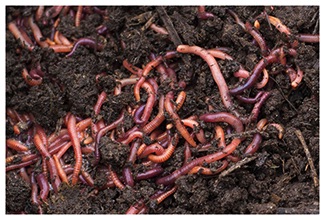Harmony House
SUSTAINABLE LIVING IN THE MODERN WORLD
WASTE
It's a fun fact of life that our family's sewage is enthusistically processed by a sizeable colony of friendly composting worms! Being able to deal with all our black and grey water in this very natural and non-polluting way is a big step forward in having a small environmental footprint. Read further through this page for more information on our aims, research, decisions and results, as well as our tips and advice summary, for this element of our project - our waste management system.
OUR AIM
One of the main aims with our build was to be as sustainable as possible and off-the-grid, so an independent waste management system was our intention from the outset. Our property is also just outside of town water and sewage services, making an independent waste management system the only option.
Our reading suggests that independent waste management systems are still sometimes achievable in town and suburban settings, depending on your local council and the size of your property.
OUR RESEARCH
We wanted our system to be as easy to maintain as possible, with minimal power use.
The option that attracted our attention right away were the “worm farm septic systems” that a small handful of operators offer. These basically consist of an underground holding tank where household sewage and grey water is deposited onto a raised porous platform. The solids are retained on the platform and processed by a large colony of composting worms, while liquids drain through to lower levels where microbes continue the processing action. The resultant treated liquid (akin to liquid fertiliser) is then pumped to dispersal trench lines (the number and length of which are dictated by local council regulations) where it enriches the soil (together with worm castings from the system as an additional garden bonus!).

The whole affair is therefore as natural a process as could be: no chemicals at any point, and even the nature of the composting action itself is an aerobic one (where oxygen is present and no nasty smells are generated) rather than the anaerobic action of a traditional in-ground septic system (no oxygen present and extremely smelly if any gases escape). This aerobic composting process occurs in nature all the time, and struck us as a very sensible, healthy, and sustainable way of processing our own waste. Not only chemical-free and pollution-free (no treated waste ending up in the oceans), but also extremely energy efficient as the worms and the microbes do all the work! The only energy consuming component is usually a pump to the trench lines, that may run for 10-15 minutes a day. In some cases where a gravity fed system is possible even a pump isn’t necessary.
This all seemed a much simpler and more environmentally friendly option than any of the other types of systems we came across, so our research then concentrated on which supplier to use. This involved looking carefully at the permitting process through our local council (as some differences in our final permit could result depending on the product chosen), and doing the usual internet review searches on suppliers (which showed us that customer support can be as important as the product itself in determining the end level of customer satisfaction).
OUR DECISION
For us, the simplicity and environmental-friendliness of a worm farm septic system won hands down. We would have liked to have installed a fully gravity-fed system for an even simpler outcome, however the too-small slope of our property required a standard pumped system (and even this small “con” came with the “pro” of a more regular and even spread of liquid through the trench lines). Other details, such as tank size and number/length of trench lines, were determined by the council’s permitting process. We chose a system installed by Zenplumb, who now have an upgraded WormWorx system and a strong environmental focus with their whole range of systems and services.

THE INSTALLATION
The installation was done near the beginning of the build time-frame, and went well with the exception of a missed join leak where the pipe from the house enters the tank. This allowed ground water to enter the tank periodically during the course of the build, and caused a follow-on problem (out of place platform and microbe chamber) when it came time to commission the system with worms before we moved in. Once the issue was properly identified and rectified, our system was ready to go, with one thousand worms in some starter material on the platform waiting for… the contribution of our family.
OUR THOUGHTS ON COMPLETION
We were excited to start using the system and see first-hand the process in action. It’s fair to say that we’d never been as interested in our own waste as we now were!
OUR EXPERIENCE SO FAR
In general the system has functioned as expected - simple, easy to maintain, and effective.
Once a week (on “bin night”) we deliver our kitchen scraps to the worms via the top access hatch (just the vegetable stuff, leaving meat and dairy scraps for the council green bin). We take this opportunity to do the simple weekly checks of the system: a quick look at the top of the pole to check that the aeration ventilator is spinning freely; a quick press of the test button to check that the pump emergency alarm is operational; and a look at the compost pile and worms on the platform to confirm everything is business as usual there.

Our compost pile stabilised in size after around six months of use, and the worm activity has become satisfyingly obvious as the colony has increased in number: whereas at first we had to poke around a bit in the compost pile with a stick to see worms, now the compost pile is literally alive with multitudes of them crawling about in plain view - it looks great! And yes, as promised, no unpleasant smell, even with our heads down the hatch watching worms. There’s just a sort of composty-damp-musty aroma, not at all offensive, which surprises us somewhat considering that much of the compost pile consists of processing sewage. Natural processes can be very effective, it seems.
Our admiration of composting worms has increased accordingly. Composting worms (usually ‘Red Wrigglers’ or ‘Tiger’ worms) don’t live within soil like regular earthworms do, but are naturally active just above the soil in the vegetation layer, feeding on rotting vegetation and manure etc. So they thrive in a moist composting environment and are voracious feeders, eating their own bodyweight in food each day (our waste and kitchen scraps). We’ve read it takes around 20,000 of them to process the waste from an average family of four, so we assume our population (initially seeded with 1000 worms) is around that level now. They also reproduce quickly, laying one to three eggs at a time every one to two weeks (a very much faster reproduction rate than earthworms). This makes the system responsive and self-adjusting. For example, as our kids grow older and we produce more waste, the worm population increases with the greater availability of food, which increases the processing capacity of the system.
We enjoy the fact that our waste is processed by such a healthy and thriving living system. We also enjoy telling guests where their contributions go. In a strange way our worm farm is a part of the family, and as composting worms can apparently live for up to fifteen years, many of our helpful worms will be with us longer than our family cat.
OUR TIPS AND ADVICE SUMMARY
- Consider which types of systems suit your situation.
- Research your local council regulations carefully.
- Good councils want good outcomes, so may be more helpful than you think. Don’t be afraid to talk to them with a view to achieving positive results.
- Research your supplier carefully, as good customer service is important in a critical area such as waste management.
